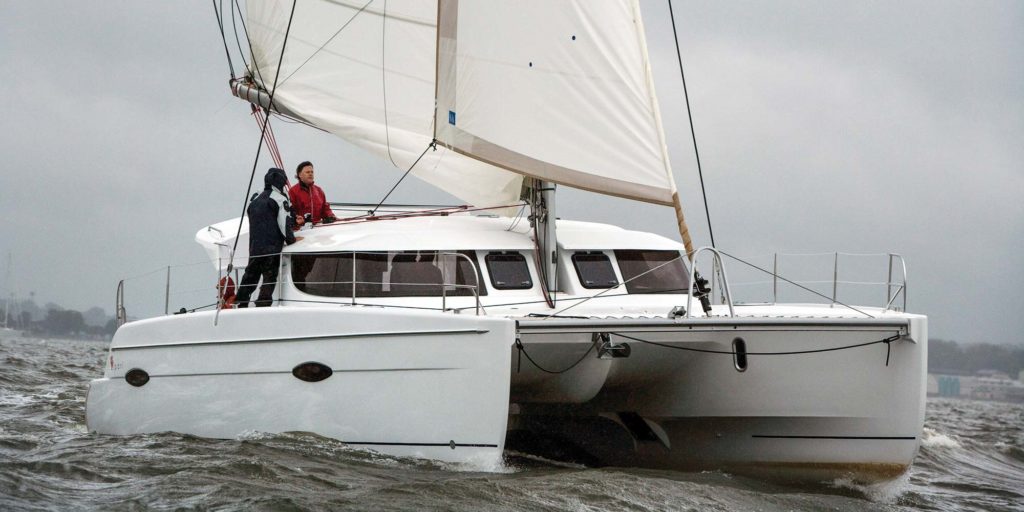
In monohull sailing, when you leave too much sail up in a building breeze the signs are clear: The rail is underwater, the dishes are on the floor, Grandma is terrified. The boat is dealing with excess energy by trying to lever a 5-ton lead weight out of the water; in other words, it’s heeling, spilling breeze, slowing down and rounding up.
Multihulls don’t behave that way. When you overpower a cat, it can only accelerate, dig a hole in the water or bust gear. No-heel sailing has a lot of advantages, but one drawback is the temptation to sail badly. You might easily go sailing with breakfast dishes on the table and postpone reefing until you’ve cleaned things up. In the meantime, the breeze is on, the boat’s impossible to steer and you shred a sail. One key to safe catamaran sailing is to learn when — and how — to reduce sail.
The best place to learn how to tuck in a reef is at the dock. Pick a morning with zero wind, and hoist. Practice reefing and un-reefing till you can do it in less than three minutes, blindfolded. If something jams or snags, stop. Find the source, figure out the cause and fix it. Look for inherent weak spots, chafe areas and jammed lines or sail slides. Study the whole system in slow motion and imagine how it will behave in howling wind, thrashing seas or on pitch-dark nights.
With the main down and flaked on the boom, go to the mast and haul up the main halyard, hoisting the sail as far as you can with two hands and no winch. Let it drop. Repeat and get a feel for the amount of friction built in to this most simple system. Then, if your lines lead to the cockpit, go back and repeat the procedure from where you would normally hoist the sail. Note how every bend and turn adds friction.
It’s important to have a solid understanding of your boat’s base-line resistance. When something jams in the dark, at sea, and you’re alone in the cockpit, you have to know nature’s little warning signs. Your evil inner voice will say, “You’re just tired. Put that thing on the electric winch!” You have to be able to argue back, “No, this is not the normal amount of friction. Something’s wrong.” Remember: There are no snag problems an electric winch can’t make worse.
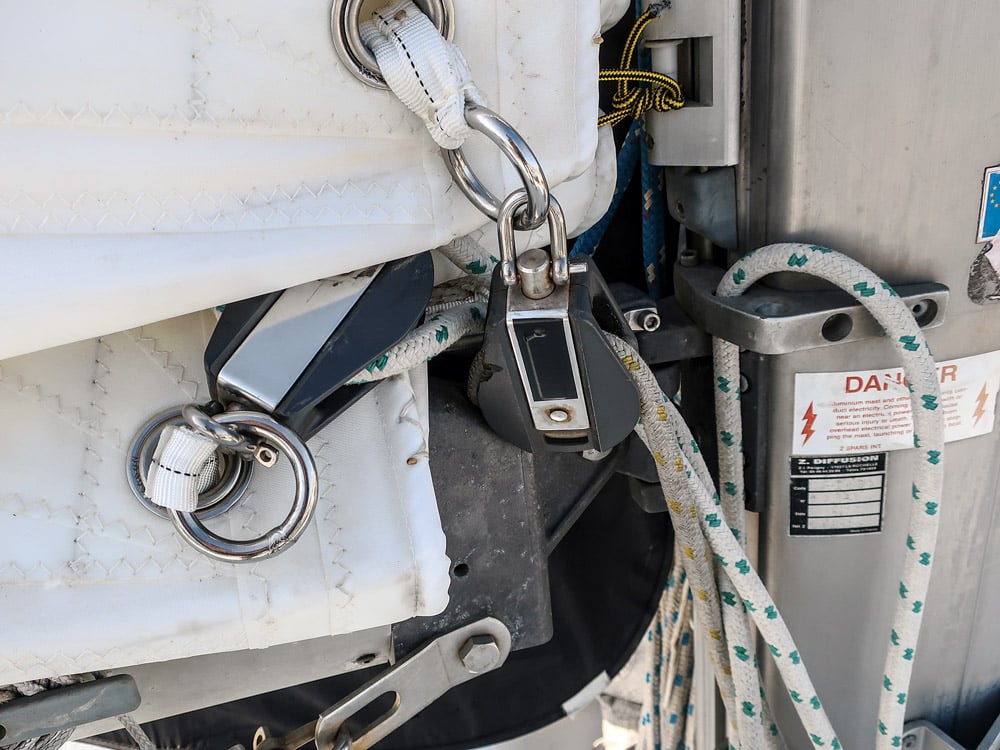
While you’re at the mast, study the gooseneck. With the first reef in, look at the way the reef line is led to the deck and back to the cockpit. Look for friction and chafe. Push the boom out and back, making sure the reef line doesn’t change tension. Look back at the tail end of the boom, where the reef line passes through the leech. The reef line should pull both reef points in two directions: down and forward at the luff, and down and back at the leech. It should run through all its turns, from boom to cockpit, with minimal resistance. It might appear to be all clean and peaceful at the dock, but on big seas, everything is in motion. The slightest chafe whittles line down to bird-nest fodder in no time.
Next, work out your own checklist for reefing. It should be a simple list of the basic steps, in an order that goes something like this: 1) Ease mainsheet. 2) Set topping lift. 3) Ease halyard. 4) Tighten and secure reef line. 5) Re-tension halyard. 6) Trim sheet.
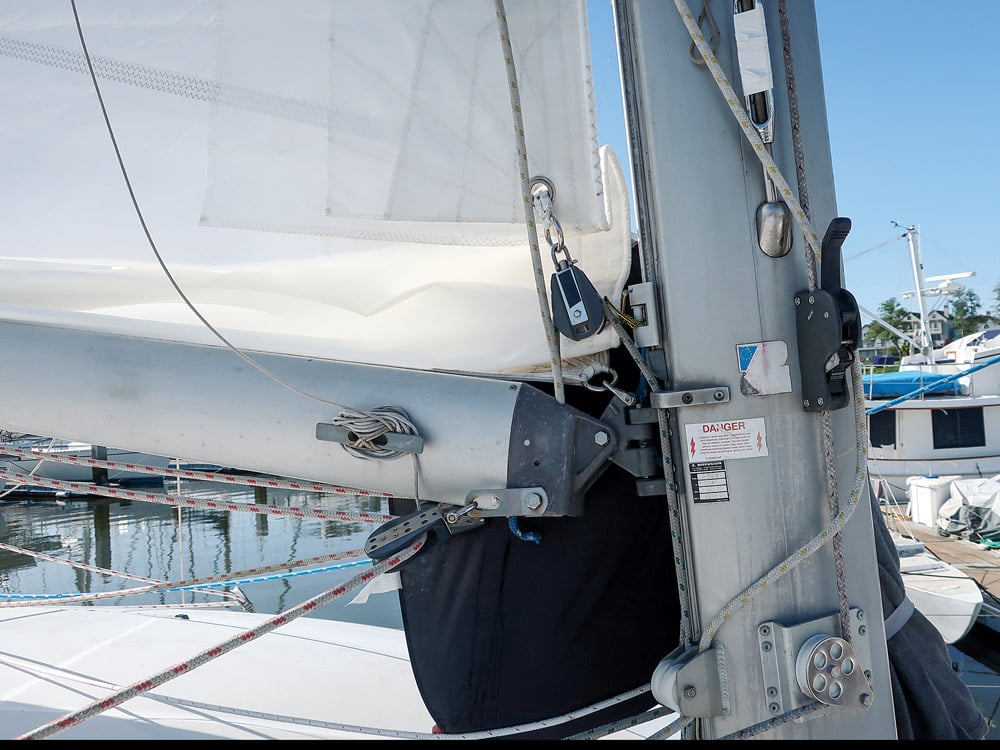
Reach for It
Once you’ve got it down pat at the dock and you’re ready for a test run, pack a lunch and look for a steady 15-knot breeze with plenty of sea room. Set a heading on a close reach, check sea room again and punch in the autopilot. Watch the autopilot drive for five minutes while you review your checklist.
When you’re ready, ease the mainsheet and let the traveler down until the main is completely de-powered. Adjust jib trim and autopilot heading until the boat stays on course, powered only by the jib; don’t fall off and let the luffing main fill again. The speed will go down sailing only on the jib, but the boat should balance, still on a close reach. Now go through your checklist and practice it step by step for both the first and second reef, hauling the sail up and down until you have it down cold or run out of sea room.
Reefing on a close reach has its own tricks and hassles, but I find it far easier than starting engines, pushing the bow into the wind, leaping off wave crests, pounding in troughs, watching for stray lines in the props and minding the flogging boom.
In the distant past, when mainsails had short (or no) battens, the sail flogged when luffing. This was considered hard on the sailcloth. The full-length battens on modern catamaran mainsails take the flog out of the sail but put it in the boom. This is considered hard on skulls, should they be in the way. An out-of-control boom also flails slack lines, which snag, bend, remove hardware and tie themselves in weird knots. It’s a deadly menace to life and property. I try to avoid it at every opportunity. Still, it’s good to practice reefing nose-to-wind, and also heaving to. It’s difficult, it tests boathandling skills and it helps prepare you for the toughest challenge: reefing while sailing on a run.
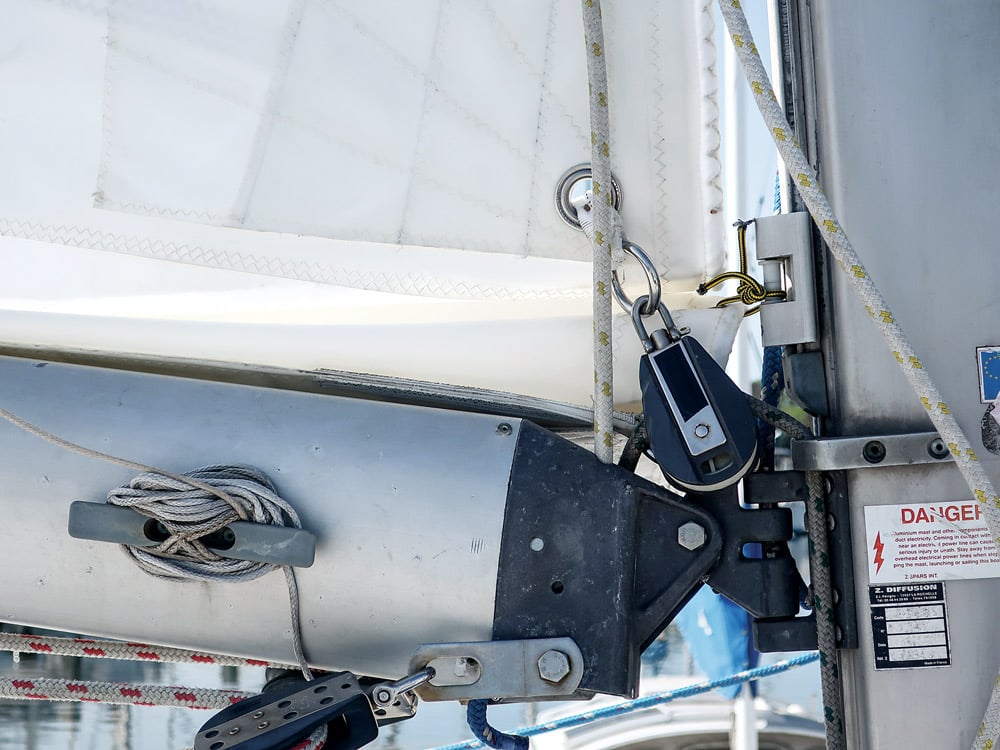
Before we head off downwind, let’s heave to for a minute and review. We like to practice at the dock, in dead calm, because, well, it’s calm. Everything’s easy.
So how to know when to reef? The first obvious answer is the wind-speed indicator. If your boat has an owner’s manual, it probably recommends reefing at 18, 28 and 35 knots or so. Every boat is different, and no rule fits every situation, but take it on faith that these are ballpark figures. Pick your own numbers, but be conservative, watch the wind speedo (hopefully it’s been calibrated) and stick to your rules till you know your boat well.
Do you put in the first reef at 18 knots true or apparent? Great question. Most cats pick up a lot of speed when they head downwind. This exaggerates the difference between true-and apparent-wind speed. You’ll especially notice this if you have set a gennaker or spinnaker and the wind is building. If you head up even a few degrees on these sails, the apparent-wind speed builds so fast you might have a shredded sail quicker than you can say “snap fill.”

Write your reefing-guide checklist with true-wind speed in mind, and make a note to clearly understand how your boat’s speed and heading affect apparent-wind speed and angle. Then make a note on the dashboard for downwind drivers: “Steer down in a puff.” The deeper downwind angle you sail, the less the apparent wind. And vice versa.
Most catamarans have shrouds placed far aft, and no backstay. That means the boom cannot swing out as far as on typical monohulls, and therefore the jibe angle is smaller. The boat has a narrower range of downwind sailing angles. For this reason, and a few other architectural ones, cat sailors don’t often sail dead downwind, at least not with the main up. It’s a big sail, with lots of roach in the leech; long, heavy battens; and, on many boats, a traveler that’s 10 or more feet long. When you jibe one of these accidentally in 25 knots, it’s like lifting a cat by the tail: You discover new things that can’t be learned any other way.
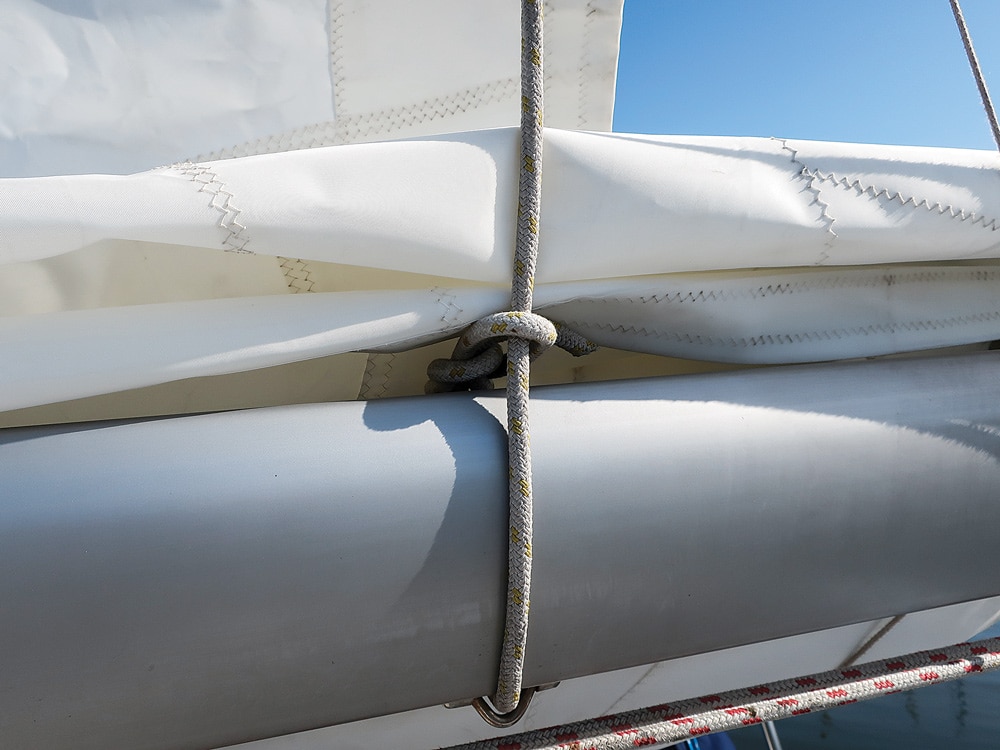
A lot of good sailors will say you can’t reef that big sail when it’s loaded on a run. But something about turning into a huge following sea is a motivator to try. When you turn into the wind to reef, and start taking big waves on the beam, even though you know that in theory your boat was designed not to capsize, all your senses will scream, “We’re going over!”
So before you get caught out in 20-foot seas with too much canvas up, it’s best to learn how to reef the big main while sailing hard, downwind.
Downwind Basics
You can work out the basic moves and hardware at the dock. But to feel the pressure, the friction you’re up against when sailing on a run, it’s good to have a long stretch of wide, flat water and at least 15 knots of steady breeze.
If you have the luxury of crew, this is the time to put your best downwind driver at the wheel. If you are cruising alone, or with a mate, your autopilot is your best friend and the most important piece of gear on the boat. Most autopilots have a wind function; instead of a magnetic heading, they will steer to an apparent-wind direction. This is where you learn to use it, adjust it and trust it. The boat has to maintain a rock-solid wind angle, and you need to be able to tweak it a few degrees, up or down, and trust it won’t lurch into a round-down wild jibe.
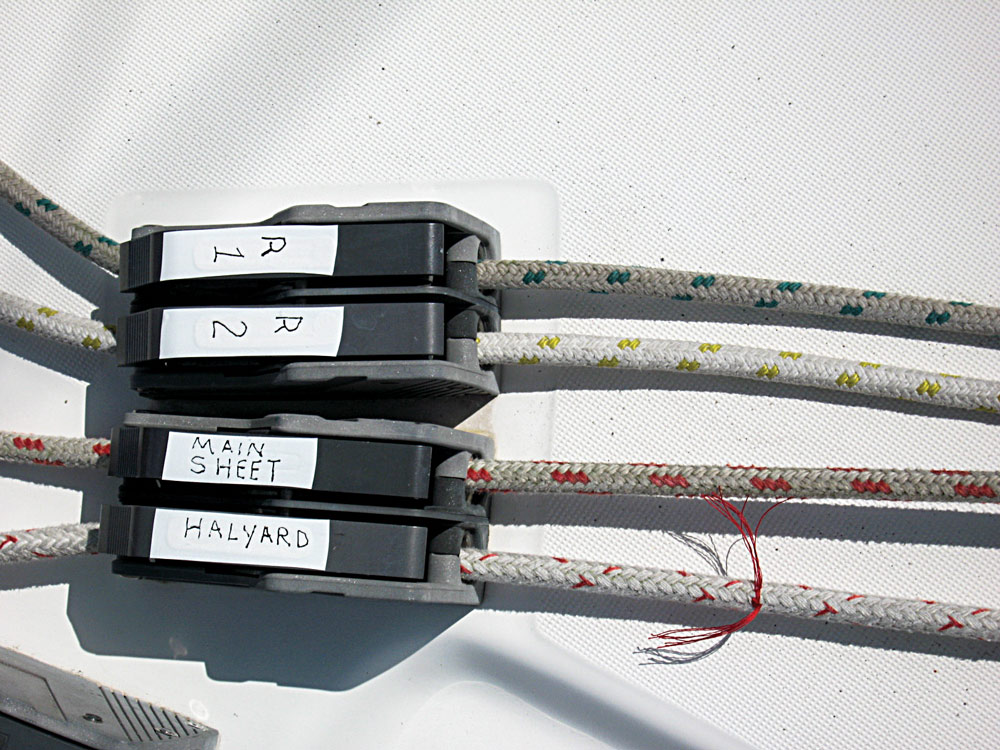
Before you punch the autopilot into duty, set your heading and sail trim on a deep downwind angle that’s balanced and easy to steer. If you’re struggling, zigging off and zagging back, fighting a heavy wheel, the pilot will struggle too. Eventually something will break. If your heading swings too far, the autopilot may give up trying to hold course and eventually switch itself off. (There’s a Catch-22 to all this: If you’re overpowered and out of balance, it’s hard to safely reef because it’s hard to hold course. But this is when you need that reef the most. Practice in lighter breeze and work up to the big stuff. And learn to reef sooner rather than later.)
Even in lighter wind, with the main sheeted out and traveler down, there’s plenty of friction on the mainsail’s luff cars. The sail likely won’t come down on its own, and even the reef line on a winch won’t feel effective. The simplest solution is for someone to stand at the mast and pull down on the luff of the sail. If you can safely get there in the dark and reach the sail, this method, being the simplest, has beauty.
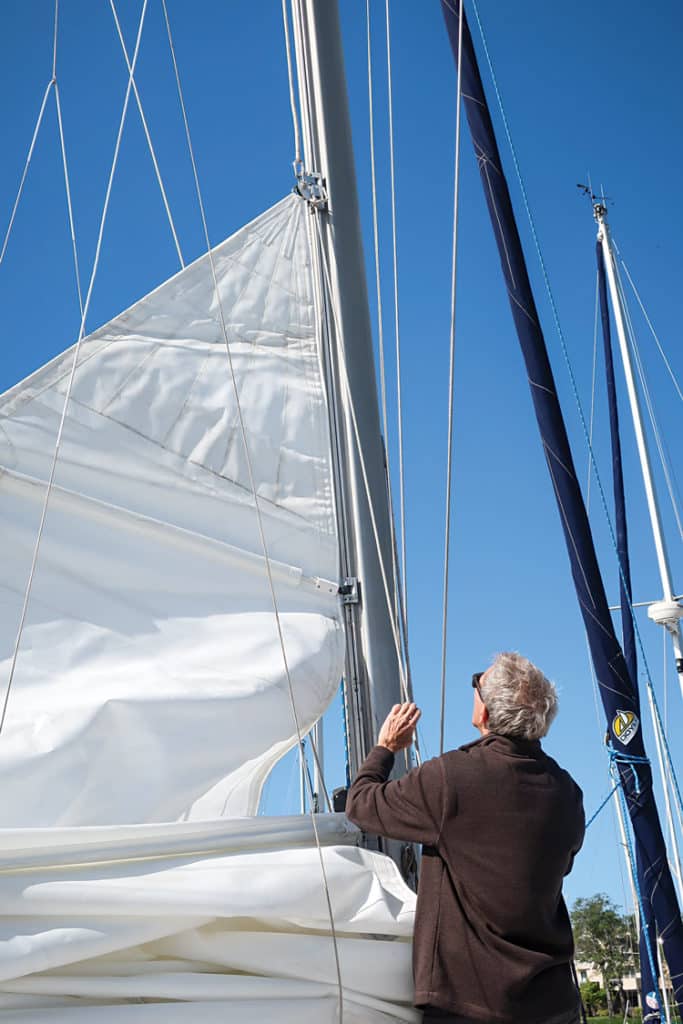
But regardless, you already thought about this back at the dock, and you have rigged some kind of downhaul that lets you pull down on the sail from a position where you feel safe. It can be as simple as a separate line, tied to the top luff car, that is led to the base of the mast, or better yet to a manual winch either on the mast, cabin top or at the helm (to be used as a last resort!).
There are times when even an athlete at the mast, using a well-rigged downhaul, won’t budge the sail. Try bringing the mainsheet in 2 feet and try again. No? Alter heading slightly and try again. Bring in a couple more feet of sheet. Double-check the main halyard. No snags? Keep tinkering with sheet angle and heading, downhaul and reef-line pressure in tiny increments — but don’t jibe! Try even moving the traveler up a foot or two. Remember, the reef line has to pull the boom up a bit to meet the lowering leech cringle, so changing the sheet geometry can help.
If all else fails, you might have to put your downhaul on the (manual!) winch. Here, again, all your dock practice pays off because you need a good feel for how much friction is too much. You need to know if something is about to break.
If you keep tweaking the sheet and heading in small bites, and you don’t break something, the sail will finally move down an inch or two, and that’s all you need, a start. From there you can keep inching it down.
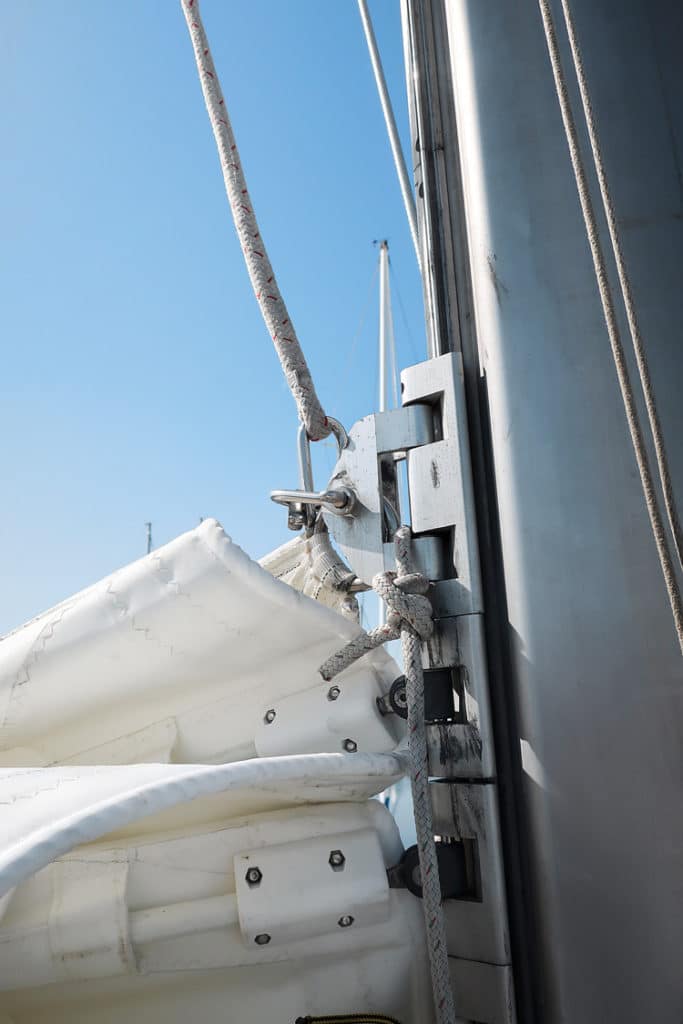
When you have the reef point locked down, give the autopilot a break. Steer the boat to see if it’s easier and better balanced with less sail. If you still have sea room in your practice space, take a break, open the lunch bag, review your checklist and then practice reefing the jib. You’ll find challenges there too in big wind, even though it rolls up.
Practice Makes Perfect
Every boat and every sea condition is a little different. Experimenting in all kinds of settings is the only way to learn the personality of your boat. There are devilish details: lazy jacks that snag battens, sail covers and Biminis that block the view. Besides their sails, catamarans have lots of sail area in fiberglass and gelcoat. When you’re sailing downwind, all that vertical surface you see from behind equates to sail area, and most of it is aft of the mast. I’ve sailed cats at more than 17 knots with no sails at all! So the dynamic balance of a cat is different from a monohull.
When you start tinkering, you’ll find most cats sail well, even tacking upwind, on jib alone. But they hardly sail at all on just the main. As big as the main is, that seems counterintuitive. But when I’m alone on the boat and both engines die at the worst moment, the first thing I reach for is the jib sheet and furling line. Before the anchor, before the radio, before the life jacket, I roll out the jib. Try it.
Learn your boat! When you understand how it reacts in various conditions, you’ll pick up other little clues that tell you if it’s overpowered. I can tell a lot just from the sound of the water tumbling off the transom. There are lots of cat sailors out there now. Go to school on the stuff they broke. Like electrics, every mechanical system should have a fuse. If you break something, before you beef it up, ask yourself if that was the best place for an overload failure. A raceboat owner summed that up best for me years ago, and I never forgot: “Guys, we sailed hard enough to break some stuff, but it wasn’t expensive. Great job!”
Don Margraf is a West Coast multihull sailor, rigger and yacht broker who mastered the finer points of boathandling at Trial & Error U.








